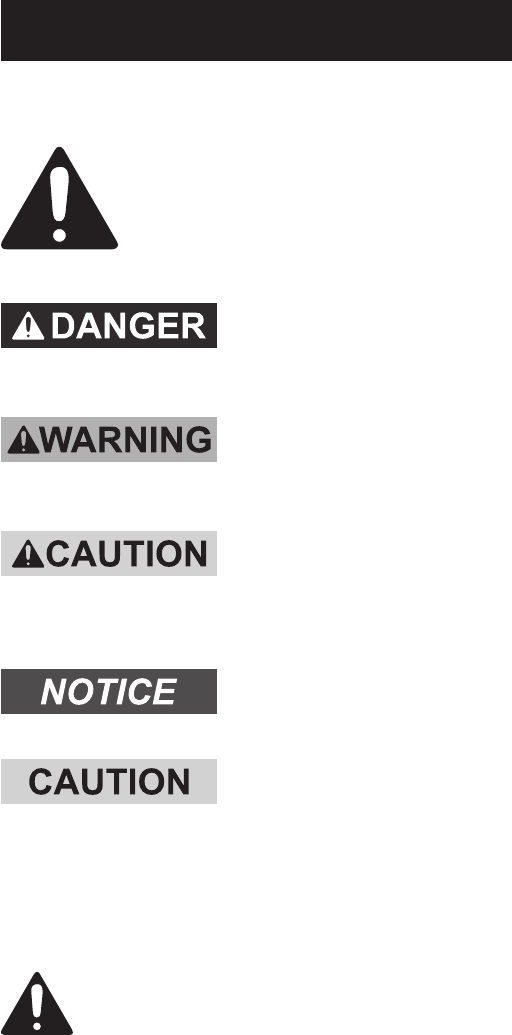
Page 3
For technical questions, please call 1-800-444-3353.
SKU 67501/68740
Save This Manual
Keep this manual for the safety warnings
and precautions, assembly, operating, inspection,
maintenance and cleaning procedures. Write the
product’s serial number in the back of the manual near
the assembly diagram (or month and year of purchase
if product has no number). Keep this manual and the
receipt in a safe and dry place for future reference.
Important Safety Information
In this manual, on the labeling, and all other
information provided with this product:
This is the safety alert symbol. It is
used to alert you to potential personal
injury hazards. Obey all safety
messages that follow this symbol to
avoid possible injury or death.
DANGER indicates a
hazardous situation which, if
not avoided, will result in death or serious
injury.
WARNING indicates a
hazardous situation which, if
not avoided, could result in death or
serious injury.
CAUTION, used with the
safety alert symbol,
indicates a hazardous situation which, if
not avoided, could result in minor or
moderate injury.
NOTICE is used to address
practices not related to
personal injury.
CAUTION, without the safety
alert symbol, is used to
address practices not related to personal
injury.
General Compressor Safety
Warnings
WARNING Read all safety warnings and
instructions. Failure to follow the warnings and
instructions may result in electric shock, re and/
or serious injury.
Save all warnings and instructions for future
reference.
1. Work area safety
a. Keep work area clean and well lit. Cluttered or
dark areas invite accidents.
b. Do not operate the Compressor in explosive
atmospheres, such as in the presence of
ammable liquids, gases or dust. Compressor
motors produce sparks which may ignite the dust or
fumes.
c. Keep children and bystanders away from an
operating compressor.
2. Electrical safety
a. Compressor plugs must match the outlet.
Never modify the plug in any way. Do not use
any adapter plugs with a grounded compressor.
Standard plugs and matching outlets will reduce
risk of electric shock.
b. Do not expose the compressor to rain or wet
conditions. Water entering a compressor will
increase the risk of electric shock.
c. Do not abuse the cord. Never use the cord
for pulling or unplugging the compressor.
Keep cord away from heat, oil, sharp edges
or moving parts. Damaged or entangled cords
increase the risk of electric shock.
3. Personal safety
a. Stay alert, watch what you are doing and
use common sense when operating this
compressor. Do not use this compressor while
you are tired or under the inuence of drugs,
alcohol or medication. A moment of inattention
while operating a compressor may result in serious
personal injury.
b. Use personal protective equipment. Always
wear eye protection. Safety equipment such as
a dust mask, non-skid safety shoes, hard hat, or
hearing protection used for appropriate conditions
will reduce personal injuries.
c. Prevent unintentional starting. Ensure the
switch is in the off-position before connecting
to power source or moving the compressor.
d. Only use safety equipment that has been
approved by an appropriate standards agency.
Unapproved safety equipment may not provide
adequate protection. Eye protection must be ANSI-
approved and breathing protection must be NIOSH-
approved for the specic hazards in the work area.
4. Compressor use and care
a. Do not use the compressor if the switch does
not turn it on and off. Any compressor that
cannot be controlled with the switch is dangerous
and must be repaired.
b. Disconnect the plug from the power source
of the compressor before making any
adjustments, changing accessories, or storing
it. Such preventive safety measures reduce the
risk of starting the compressor accidentally.
c. Store an idle compressor out of the reach of
children and do not allow persons unfamiliar
with the compressor or these instructions to


















